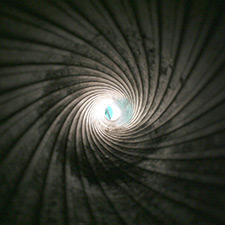Home | Glossary | Resources | Help | Contact Us | Course Map
Archival Notice
This is an archive page that is no longer being updated. It may contain outdated information and links may no longer function as originally intended.
Rifling
Equipping the barrel with the spiral grooves that spin-stabilize a bullet is the essential operation that defines an entire category of firearms.
There are four ways to produce the grooves:
- Cut rifling
- Single-point rifling
- Broached rifling
- Button-swaged rifling
- Forged rifling
- Electron discharge machining (EDM)
Electrochemical Rifling
In a process that eliminates the conventional machining of metal, rifling is formed by wet-etching the interior of a barrel under an electric current. The metal inside the barrel is actually eaten away or dissolved to create grooves in the barrel. An electrode (cathode) that has metal strips in the shape of the rifling is placed in the barrel (anode) and the assembly is submerged in a salt solution. An electric current is applied and the electrode is moved down the length of the barrel and twisted to create the spiral shaped grooves. As the current travels from the barrel to the electrode, metal is removed by electrolysis, thus forming the grooves in the barrel. This process creates the rifling in the barrel very quickly and does not require consumable tooling.
Each rifling method has unique features, and the method of rifling can have an important influence on the firearm examiner as he considers a bullet comparison.
A Permission is granted to copy, distribute and/or modify this document under the terms of the GNU Free Documentation License, Version 1.2 or any later version published by the Free Software Foundation; with no Invariant Sections, no Front-Cover Texts, and no Back-Cover Texts.
Additional Online Courses
- What Every First Responding Officer Should Know About DNA Evidence
- Collecting DNA Evidence at Property Crime Scenes
- DNA – A Prosecutor’s Practice Notebook
- Crime Scene and DNA Basics
- Laboratory Safety Programs
- DNA Amplification
- Population Genetics and Statistics
- Non-STR DNA Markers: SNPs, Y-STRs, LCN and mtDNA
- Firearms Examiner Training
- Forensic DNA Education for Law Enforcement Decisionmakers
- What Every Investigator and Evidence Technician Should Know About DNA Evidence
- Principles of Forensic DNA for Officers of the Court
- Law 101: Legal Guide for the Forensic Expert
- Laboratory Orientation and Testing of Body Fluids and Tissues
- DNA Extraction and Quantitation
- STR Data Analysis and Interpretation
- Communication Skills, Report Writing, and Courtroom Testimony
- Español for Law Enforcement
- Amplified DNA Product Separation for Forensic Analysts


